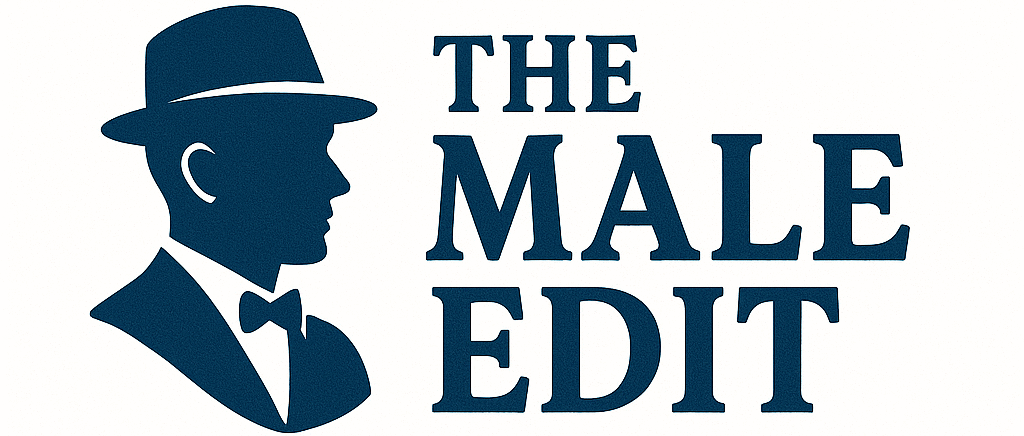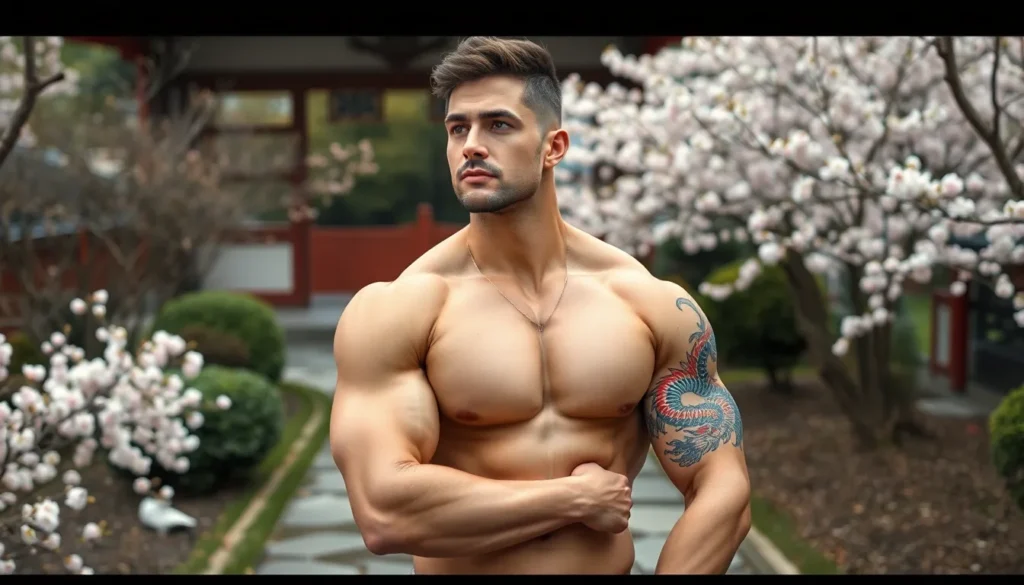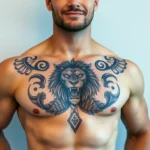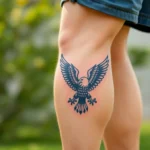Japanese tattoo art represents one of the industry’s most captivating and meaningful forms of body art. We’ve seen countless men drawn to the rich symbolism powerful imagery and stunning aesthetics that define traditional Japanese tattooing. From fierce dragons and protective koi fish to cherry blossoms and samurai warriors these designs tell stories that resonate deeply with masculine energy and personal transformation.
The beauty of Japanese tattoos lies in their versatility and profound cultural significance. Whether you’re considering your first tattoo or adding to an existing collection we understand the importance of choosing designs that reflect your personality and values. These timeless motifs offer endless possibilities for customization while maintaining their authentic cultural roots.
We’ve curated an extensive collection of Japanese tattoo ideas specifically customized for men who appreciate artistry with meaning. Each design carries centuries of tradition and symbolism that can enhance your personal story while creating a striking visual impact that commands respect and admiration.
Traditional Dragon Tattoo Designs for Masculine Appeal
Dragon tattoos represent the pinnacle of Japanese masculine artistry, embodying power and spiritual wisdom that resonates deeply with men seeking meaningful body art. We’ve observed how these legendary creatures transform the male physique into a canvas of ancient symbolism and modern aesthetic appeal.
Eastern Dragon vs. Western Dragon Symbolism
Eastern dragons symbolize benevolent forces of nature, wisdom, and good fortune in Japanese tattoo tradition. These serpentine creatures flow gracefully across the skin with elongated bodies, whiskers, and four legs, representing protection and spiritual guidance rather than destruction. Japanese dragon designs typically feature scales that catch light beautifully, creating ever-changing movement patterns that enhance masculine muscle definition.
Western dragons contrast sharply with their Eastern counterparts by representing conquest, strength, and fierce independence. These winged beasts appear more aggressive with broader wings, sharper claws, and fire breathing capabilities that appeal to men seeking bold, intimidating imagery. We recommend Eastern dragon styles for men who value wisdom and spiritual growth, while Western interpretations suit those drawn to warrior aesthetics and raw power.
Placement Options for Dragon Tattoos
Back pieces offer the most spectacular canvas for full dragon designs, allowing artists to create sweeping compositions that wrap around the torso naturally. These large scale placements showcase intricate details like scales, clouds, and water elements that make Japanese dragon tattoos truly magnificent. Full back dragon tattoos typically require 15 to 25 sessions to complete, depending on complexity and color saturation.
Sleeve placements provide excellent visibility while maintaining professional flexibility with strategic positioning. Dragon sleeves can wind around the arm from shoulder to wrist, creating a three dimensional effect that moves with muscle flexion. Quarter sleeves work perfectly for men who want impactful dragon imagery without full arm commitment.
Chest and shoulder combinations create powerful focal points that emphasize masculine upper body structure. These placements allow dragons to emerge from shoulder blades or wrap across pectoral muscles, creating dramatic visual impact during shirtless activities. Rib cage placements offer more discrete options while still providing substantial space for detailed dragon artwork.
Color Schemes and Artistic Styles
Traditional Japanese color palettes emphasize deep blues, vibrant reds, and golden yellows that create striking contrast against skin tones. Blue dragons represent wisdom and tranquility, making them ideal for men seeking spiritual significance in their tattoo choices. Red dragons symbolize passion and strength, while black dragons convey mystery and power through bold monochromatic designs.
Water elements surrounding dragons typically feature blues and whites that create movement and depth within the overall composition. Cloud backgrounds use soft grays and whites to provide atmospheric context without overwhelming the dragon’s prominence. Gold accents on scales, claws, and eyes add luxurious touches that catch light and enhance the tattoo’s three dimensional appearance.
Modern interpretations blend traditional Japanese techniques with contemporary artistic styles, creating unique fusion pieces. Realistic shading techniques combined with traditional Japanese line work produce dragons that appear to leap from the skin. Geometric elements integrated with organic dragon forms appeal to men who appreciate both ancient symbolism and modern aesthetic sensibilities.
Powerful Samurai Warrior Tattoo Concepts
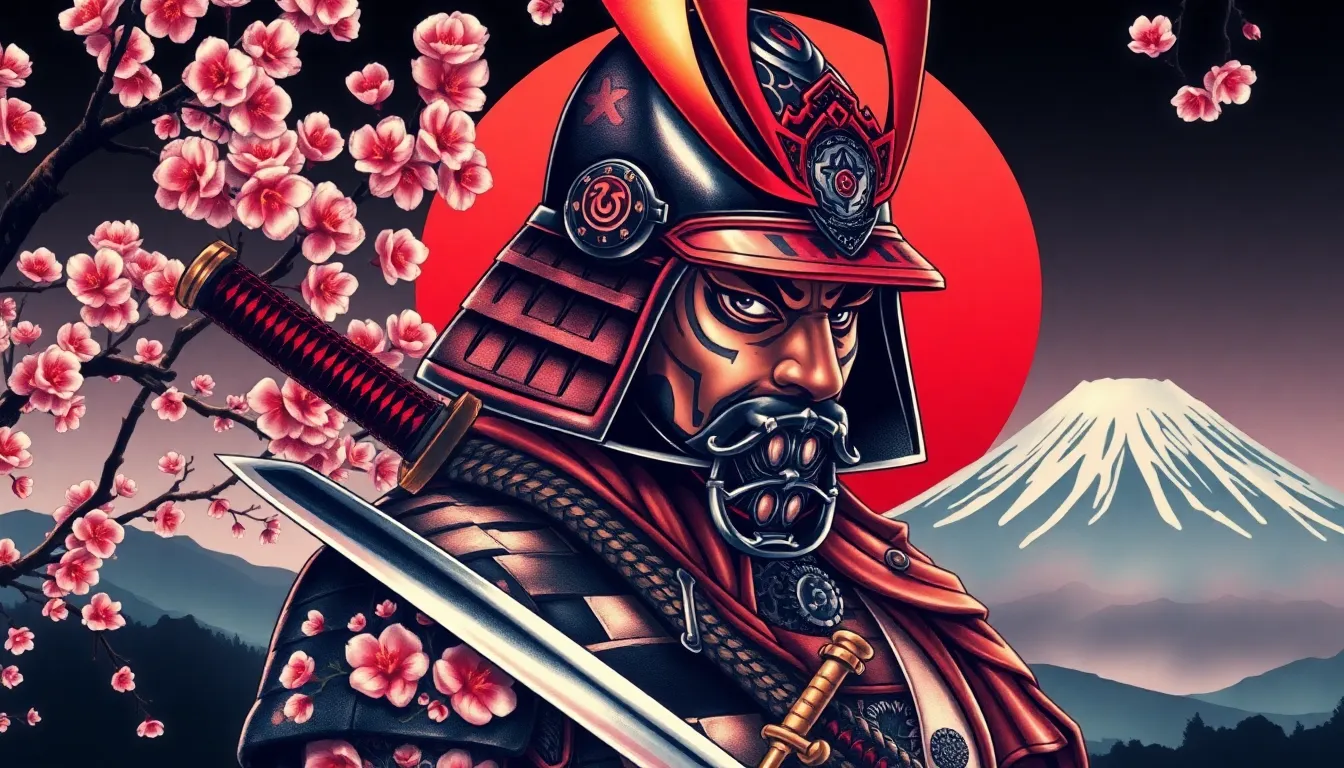
Moving from the mystical area of dragons, we explore the fierce industry of samurai warriors that embody the ultimate masculine principles of honor, discipline, and unwavering strength. These legendary figures represent the pinnacle of Japanese warrior culture, offering men powerful tattoo concepts rooted in the sacred Bushido code.
Historical Samurai Figures and Their Stories
Miyamoto Musashi stands as the most celebrated swordsman in Japanese history, making him an exceptional choice for men seeking tattoo designs that represent strategic thinking and martial mastery. His legendary status as an undefeated duelist who developed the two-sword fighting technique creates compelling visual narratives for body art. Oda Nobunaga offers another powerful reference point, representing revolutionary leadership and the courage to challenge traditional structures during Japan’s turbulent political period from the 12th to 19th century.
Takeda Shingen provides inspiration for tattoos focused on military genius and clan loyalty, while his distinctive armor and battle formations create ever-changing composition opportunities. We find these historical figures particularly meaningful because they shaped Japan’s cultural identity through their individual virtues of strategy, bravery, and unwavering leadership principles.
Armor and Weapon Details in Tattoo Art
Kabuto helmets serve as striking focal points in samurai tattoos, featuring intricate ornamental crests and distinctive shapes that represent exact ranks and clan affiliations. These elaborate headpieces often include menpo masks that add dramatic intensity to warrior portraits. Traditional armor plating creates opportunities for detailed shading work, with layered segments and decorative elements that showcase the artist’s technical skill.
Katana swords dominate weapon imagery in samurai tattoos, frequently depicted at dramatic angles or being drawn from ornate sheaths to emphasize the warrior’s readiness and exceptional skill. Artists often incorporate yari spears and other traditional weapons to create comprehensive battle scenes. Color schemes range from vibrant traditional Japanese hues like deep blues and crimson reds to sophisticated black and grey work that emphasizes depth and dramatic contrast.
Full Sleeve vs. Partial Samurai Designs
Full sleeve tattoos provide expansive canvas space for elaborate storytelling, allowing artists to combine samurai figures with complementary Japanese motifs like cherry blossoms, dragons, temples, and Mount Fuji. These comprehensive designs create cohesive narratives that showcase the warrior’s environment, legendary battles, and cultural symbolism in one unified artwork. Narrative quality becomes the primary advantage of full sleeve work, offering visual impact that tells complete stories about honor and tradition.
Partial designs focus on single powerful elements such as samurai busts, distinctive helmets, or dramatic katana presentations on forearm, shoulder, or chest placements. These smaller tattoos maintain subtlety while conveying strength and heritage through carefully chosen details. Minimalist backgrounds often accompany partial designs, using selective ornamental elements that support the main subject without overwhelming the composition.
Iconic Koi Fish Tattoo Variations
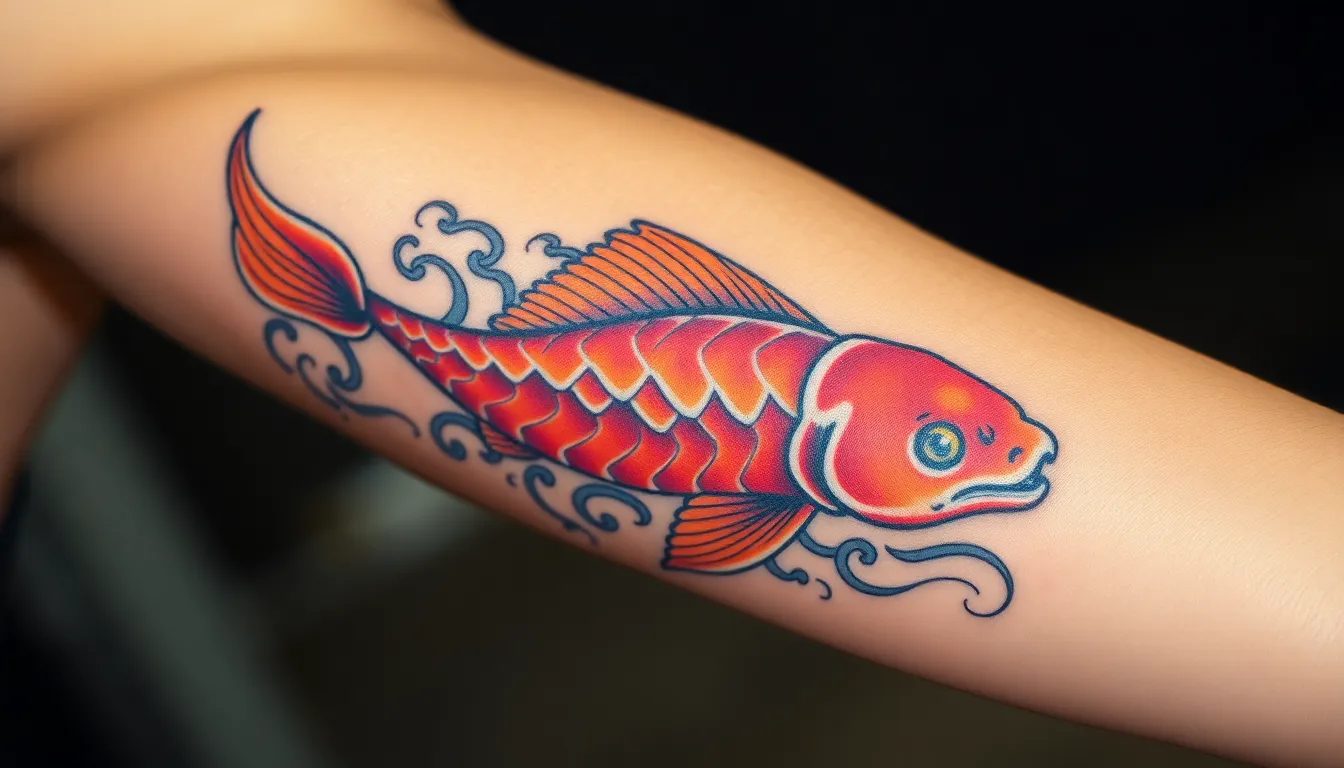
Moving beyond the warrior’s path, we encounter the profound symbolism of koi fish tattoos, which represent perseverance, transformation, and masculine strength through their graceful yet powerful imagery.
Koi Swimming Upstream Symbolism
Swimming upstream motifs capture the essence of determination and personal growth in Japanese tattoo culture. According to legend, a koi that successfully climbs the Dragon Gate waterfall transforms into a dragon, symbolizing the ultimate achievement through perseverance. We see this powerful narrative reflected in traditional designs where bold black and red koi battle against flowing currents, their muscular forms emphasized through ever-changing positioning and dramatic water splashes.
These upstream designs embody masculine energy by showcasing the struggle against life’s obstacles. Tattoo artists often incorporate dark shadows and vibrant colors to highlight the koi’s resilience and power. The visual storytelling becomes even more compelling when we consider that each swimming stroke represents another step toward personal transformation and strength.
Black and Grey vs. Colorful Koi Designs
Monochromatic approaches offer timeless elegance through sophisticated shading and contrast techniques that emphasize form and movement. Black and grey koi tattoos focus on the fish’s natural curves and muscle definition, creating subtle yet powerful masculine statements. These designs appeal to men who prefer understated artistry while maintaining the deep cultural significance of the koi symbol.
Vibrant color schemes transform koi tattoos into striking visual masterpieces using reds, blues, and oranges to emphasize vitality and symbolic meanings. Traditional red koi surrounded by black linework convey strength, courage, and success in relationships, making them perfect for visible placements like arms or calves. Blue koi designs incorporate lighter purple hues to represent serenity and the beauty found after achieving personal goals, often favored for larger canvas areas like thighs or backs.
Color choices directly impact the tattoo’s symbolic message and visual presence on the body. Bold reds communicate passion and determination, while blues suggest wisdom and tranquility achieved through life’s journey.
Incorporating Water Elements and Waves
Water motifs enhance the sense of movement and life force within koi tattoo compositions through swirling waves and ever-changing splash patterns. Traditional Japanese wave designs frame the koi fish, reinforcing themes of fluidity, natural strength, and the ongoing journey through life’s challenges. These complementary elements create harmonious designs that emphasize the koi’s connection to its aquatic environment.
Swirling water patterns add depth and dimension to larger tattoo pieces, particularly on arm sleeves, backs, chests, and forearms where artists have sufficient space for detailed work. Wave elements often incorporate traditional Japanese artistic techniques, using curved lines and gradient shading to suggest water’s constant motion around the swimming koi.
The combination of koi and water creates a complete narrative about handling life’s currents with grace and determination. These integrated designs offer men meaningful body art that celebrates both aesthetic beauty and profound cultural symbolism.
Japanese Phoenix (Ho-Oh) Tattoo Ideas
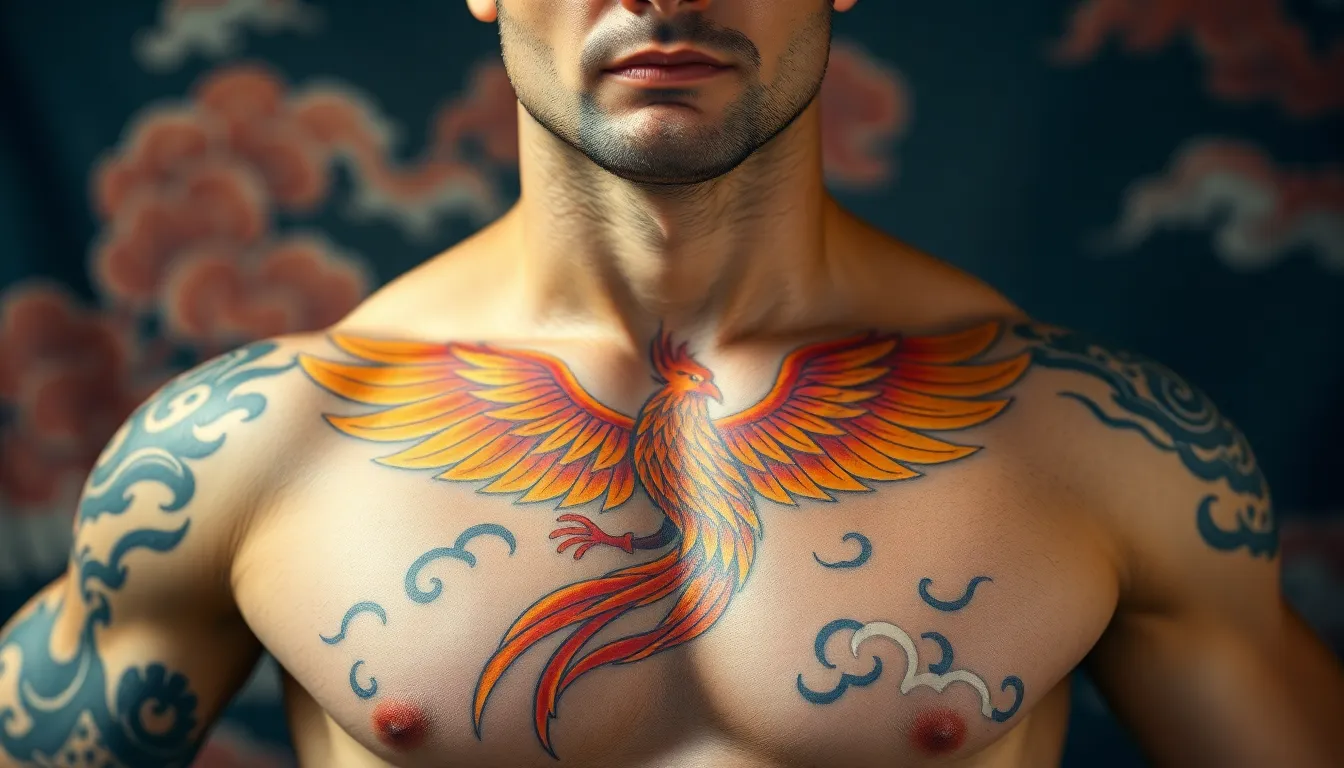
Japanese phoenix tattoos represent one of the most spiritually important designs in masculine body art. These powerful symbols bridge ancient mythology with contemporary masculine expression.
Rebirth and Transformation Meanings
Rebirth symbolism defines the core essence of Japanese phoenix tattoos, making them perfect for men who’ve overcome important life challenges. The Ho-Oh represents victory after adversity, embodying themes of spiritual renewal and personal transformation. Men choose these designs to commemorate major life transitions like career changes, relationship milestones, or recovery journeys.
Transformation themes resonate deeply with those seeking to mark their evolution from difficult circumstances. The phoenix’s mythological ability to rise from ashes translates into powerful personal narratives about emerging stronger after hardship. This symbolism creates meaningful connections between the wearer’s life story and the tattoo’s visual impact.
Hope and resilience manifest through the phoenix’s upward movement and spreading wings, representing forward momentum in life. The design captures the essence of overcoming obstacles while maintaining dignity and strength throughout the process.
Wing Span and Feather Detail Considerations
Feather patterns require intricate artistry to achieve the ever-changing visual impact that makes phoenix tattoos so compelling. Artists emphasize detailed wing structures with individual feather definition, creating texture and depth that brings the mythical bird to life on skin. These patterns can feature vibrant orange and burnt orange hues for traditional fiery aesthetics.
Wing positioning dramatically affects the tattoo’s overall energy and visual flow across the body. Spreading wings convey power and protection, while folded wings suggest contemplation and inner strength. The wing span determines how the design interacts with natural body contours and muscle definition.
Color variations offer different aesthetic approaches to feather detailing. Vibrant orange, red, and black combinations highlight the phoenix’s fiery rebirth symbolism, while black and gray designs provide elegant, timeless appeal. Monochromatic approaches emphasize fine line work and sophisticated shading techniques.
Chest and Back Placement Options
Chest placement provides an ideal canvas for phoenix tattoos with wings spread across the pectoral muscles. This positioning symbolizes protection of the heart and creates a powerful visual statement that emphasizes masculine strength. The broad chest area accommodates detailed feather work and allows the phoenix’s head to sit prominently at the sternum.
Back positioning offers the most expansive space for elaborate phoenix designs, allowing artists to create full compositions with extended wing spans. Wings can flow across shoulder blades and down the back, while tail feathers cascade toward the lower back. This placement maximizes visual impact and accommodates complex background elements like clouds and swirling patterns.
Size considerations vary significantly between chest and back placements, with back pieces allowing for larger, more detailed compositions. Chest designs focus on compact power and symmetry, while back tattoos can incorporate additional elements like traditional Japanese clouds and seasonal symbols that enhance the overall narrative.
Oni Demon Mask Tattoo Designs
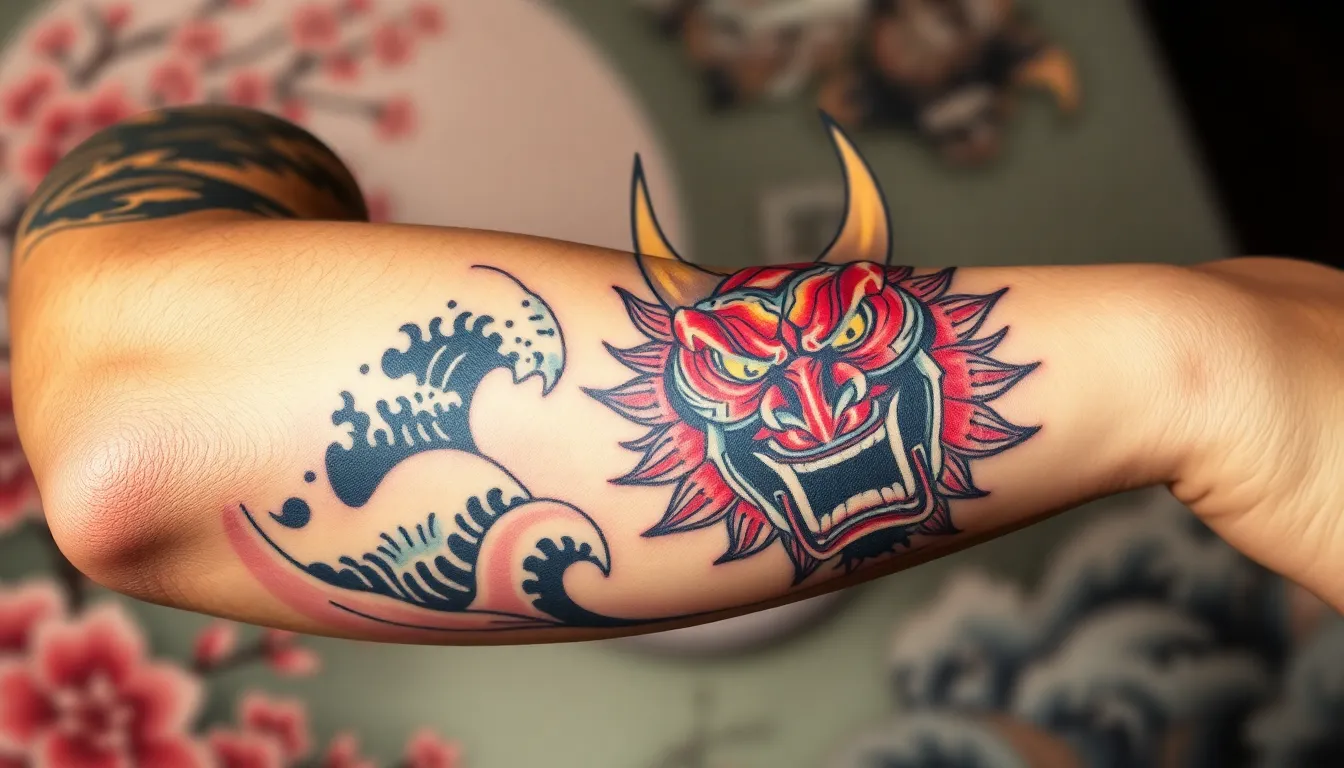
Oni demon masks represent one of the most powerful and culturally important tattoo choices in Japanese body art. These fierce, horned faces with sharp teeth and glaring eyes create an unmistakable visual impact that resonates deeply with masculine energy.
Protective vs. Menacing Oni Representations
Oni tattoos embody a fascinating duality that makes them particularly compelling for men seeking meaningful body art. Protective Oni serve as guardians, warding off evil spirits and bad luck while symbolizing the wearer’s inner strength and resilience. These designs often feature more stylized expressions and can be paired with spiritual elements like prayer beads or temple motifs.
Menacing Oni represent confrontation with adversity, emphasizing the wearer’s rebellious spirit and ability to face life’s challenges head on. These interpretations showcase more aggressive facial features and darker color palettes, reflecting inner demons or personal struggles overcome. The dual nature allows for deeply personalized expressions, with each wearer choosing the representation that best reflects their journey and mindset.
Realistic depictions focus on intricate details like textured skin, flowing hair, and dramatic shadows that bring the demon to life. Stylized versions using watercolor techniques or sketch styles offer modern interpretations while maintaining traditional symbolism. Large body placements like the back, chest, or thighs accommodate the complex details, while smaller forearm or ankle designs provide subtle yet powerful personal statements.
Traditional Japanese Theater Influences
Noh and Kabuki theater arts heavily influence Oni mask tattoo designs, adding layers of cultural depth and historical narrative to the artwork. These theatrical traditions use demon masks to portray supernatural beings and spirits, creating a rich visual language that translates beautifully into tattoo art. The dramatic expressions and exaggerated features found in theater masks enhance the symbolic qualities of Oni tattoos.
Traditional color schemes draw from theatrical makeup, incorporating deep reds, blacks, and whites that mirror stage performances. Gold accents often highlight important features like horns or teeth, creating dimensional effects that make the tattoo appear to come alive. The theatrical influence also extends to composition, with many designs incorporating dramatic angles and flowing elements that suggest movement and energy.
Modern interpretations blend traditional theater aesthetics with contemporary tattoo techniques, creating pieces that honor historical roots while appealing to today’s aesthetic preferences. These designs might incorporate abstract elements or geometric patterns while maintaining the essential character and symbolism of traditional Oni masks.
Combining Oni with Other Japanese Elements
Samurai warriors frequently appear alongside Oni masks in complex tattoo compositions, reflecting the historical practice of warriors wearing demon masks to intimidate opponents and conceal their identities. These combinations symbolize the balance between human strength and supernatural power, creating narratives about overcoming adversity through both skill and spiritual protection.
Dragons paired with Oni create powerful spiritual symbolism, representing the harmony between earthly demons and celestial beings. The contrast between the dragon’s wisdom and the Oni’s raw power creates visually striking designs that speak to themes of balance and transformation. These combinations often incorporate flowing elements like clouds or wind to connect the two figures seamlessly.
Natural elements like cherry blossoms and waves provide beautiful juxtaposition against the fierce Oni masks, creating designs that celebrate both beauty and ferocity. Cherry blossoms represent life’s fleeting nature, while waves symbolize the constant flow of change and challenge. These pairings enrich the tattoo’s story by highlighting themes of strength, protection, and spiritual balance through contrasting imagery.
Cherry Blossom (Sakura) Tattoo Combinations
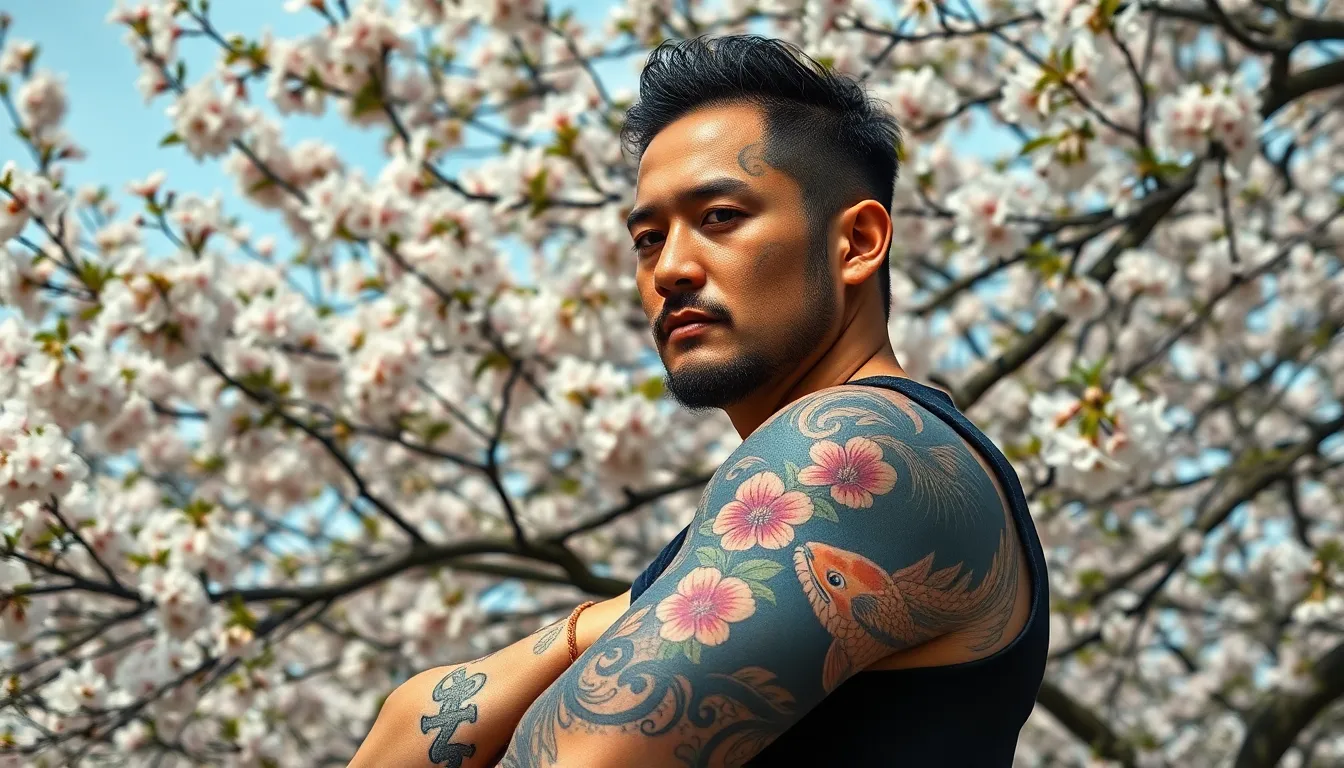
Sakura tattoos offer a unique balance of delicate beauty and profound meaning, making them increasingly popular among men who appreciate sophisticated symbolism. These blossoms complement other powerful Japanese motifs, creating stunning visual narratives that celebrate both strength and transience.
Masculine Ways to Incorporate Sakura
Bold outlines transform delicate sakura into masculine masterpieces when placed on traditionally powerful body areas like the forearm, back, or chest. Deep vibrant colors enhance the sakura’s visual impact while maintaining their inherent elegance and cultural significance. Artists often pair sakura alongside traditionally masculine motifs like warriors or tigers to create ever-changing contrasts that speak to both strength and beauty.
Strategic placement allows sakura to serve as background elements that frame larger central images, lending seasonal depth to dragon or samurai designs. Forearm placements showcase the blossoms prominently while maintaining masculine appeal through bold linework and substantial sizing. Chest pieces incorporate sakura as protective symbols, surrounding heart areas with themes of renewal and life’s precious nature.
Seasonal Symbolism and Life Cycles
Sakura’s brief spring blooming period embodies the ephemeral nature of life, symbolizing renewal, mortality, and time’s fleeting passage. These flowers highlight birth, life, and death cycles within Japanese culture, adding contemplative layers to masculine body art. Men who choose sakura tattoos often connect with deeper meanings about nature’s impermanence and life’s precious moments.
Spring renewal themes resonate with personal transformation stories, making sakura ideal for commemorating important life changes or overcome challenges. Philosophical dimensions emerge from the blossoms’ seasonal nature, appealing to men who appreciate thoughtful symbolism beyond surface aesthetics. Cultural connections to Buddhist and Shinto beliefs about life’s transient beauty add spiritual depth to these tattoo choices.
Pairing Sakura with Traditional Japanese Motifs
Dragons paired with sakura create powerful combinations that balance wisdom and beauty, representing both strength and life’s delicate nature. Koi fish swimming through sakura petals symbolize perseverance and transformation, with the blossoms representing the journey’s beautiful moments. Tigers emerging from sakura backgrounds combine power and protection with themes of renewal and seasonal change.
Samurai warriors surrounded by falling sakura petals embody honor and discipline while acknowledging life’s fleeting nature. These combinations appear in large irezumi designs characterized by bold lines and vibrant colors that soften aggressive imagery. Traditional pairings create layered meanings that appeal to men wanting both strength and elegance in their body art.
| Motif Pairing | Primary Symbolism | Cultural Significance |
|---|---|---|
| Dragons + Sakura | Wisdom, strength, protection | Balance of power and beauty |
| Koi Fish + Sakura | Perseverance, courage, transformation | Journey through life’s challenges |
| Tigers + Sakura | Power, courage, protection | Strength tempered by beauty |
| Samurai + Sakura | Honor, valor, discipline | Warrior’s appreciation of life’s fragility |
Japanese Tiger Tattoo Concepts
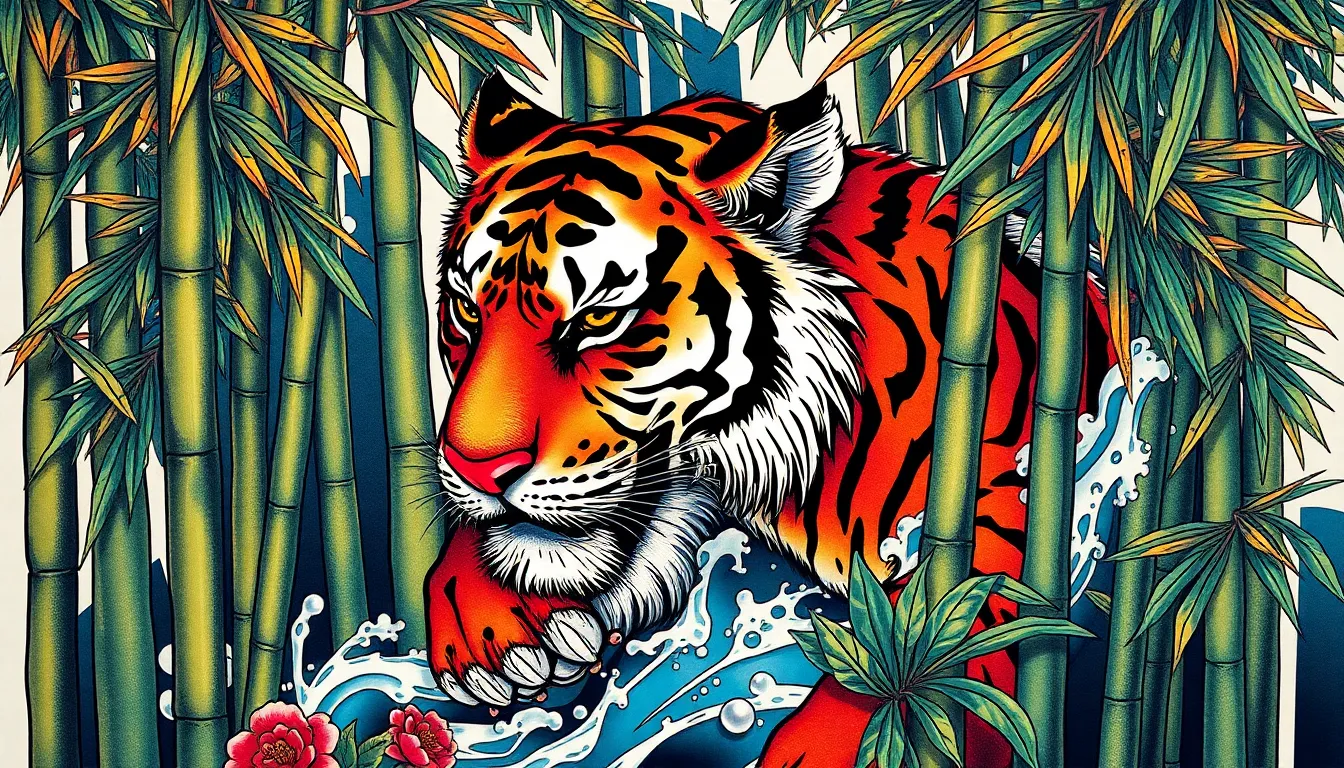
Tiger tattoos represent raw power and ferocious strength in Japanese body art, making them compelling choices for men seeking to embody courage and protection from evil spirits. These majestic designs showcase bold lines and ever-changing poses that capture the tiger’s natural elegance and untamed energy.
Tiger vs. Dragon Symbolic Balance
Tigers embody earthly power and physical strength while dragons symbolize wisdom and supernatural forces, creating one of the most dramatic themes in Japanese tattooing. We see this symbolic rivalry represent the harmonious duality between chaos and order, perfectly balancing yin and yang energies in stunning visual compositions.
Traditional irezumi artists create these tiger and dragon combinations using vivid colors and fine shading techniques that highlight their eternal struggle or unity. Men choose these designs to represent their own internal balance between raw strength and spiritual wisdom, with each element improving the power of the other.
Large scale placements on the back or full sleeves allow artists to showcase both creatures in their full glory, often depicting them circling each other or locked in symbolic combat. Ever-changing wind and water elements swirl around both figures, adding movement and energy that brings the entire composition to life.
Bamboo Forest and Natural Settings
Bamboo forests provide rich, detailed backdrops that enhance tiger tattoo compositions while adding layers of cultural symbolism to the design. These natural settings represent resilience, flexibility, and endurance, qualities that complement the tiger’s raw power with deeper philosophical meaning.
Artists incorporate bamboo stalks as vertical elements that frame the tiger’s form, creating depth and visual interest throughout the tattoo. We often see tigers positioned among dense bamboo groves, suggesting strength rooted in adaptability and the ability to thrive in challenging environments.
Natural elements like flowing water, rocky outcroppings, and mountain landscapes can accompany bamboo settings to create complete ecosystems within the tattoo. Traditional Japanese gardens inspire these backgrounds, offering peaceful contrast to the tiger’s fierce energy while maintaining visual harmony.
Cherry blossoms and maple leaves sometimes accent bamboo forest scenes, adding seasonal elements that speak to life’s transient beauty. These delicate touches soften the tiger’s intensity without diminishing its power, creating balanced compositions that appeal to men seeking both strength and sophistication.
Traditional Japanese Art Style Influences
Traditional irezumi techniques define authentic Japanese tiger tattoos through bold black outlines and distinctive color palettes featuring black, gray, red, green, and yellow. We draw inspiration from ukiyo-e woodblock prints and classical Japanese painting, emphasizing fluid movement and visual storytelling in every design.
Master tattoo artists employ ever-changing compositions that showcase the tiger’s muscular form through careful shading and line work. Traditional techniques create depth and dimension that make the tiger appear to leap from the skin, with each stripe and facial feature rendered in precise detail.
Wind bars and wave patterns often surround tiger designs, following classical Japanese artistic conventions that suggest movement and spiritual energy. These elements connect the tiger to larger cosmic forces while maintaining the bold, graphic quality that defines traditional Japanese tattooing.
Color application follows time honored methods, with deep black backgrounds making vibrant orange and red tiger fur appear more luminous and powerful. Artists layer colors carefully to achieve the rich, saturated tones that characterize authentic Japanese tattoo work, ensuring each tiger design captures both visual impact and cultural authenticity.
Geisha and Japanese Beauty Tattoo Ideas
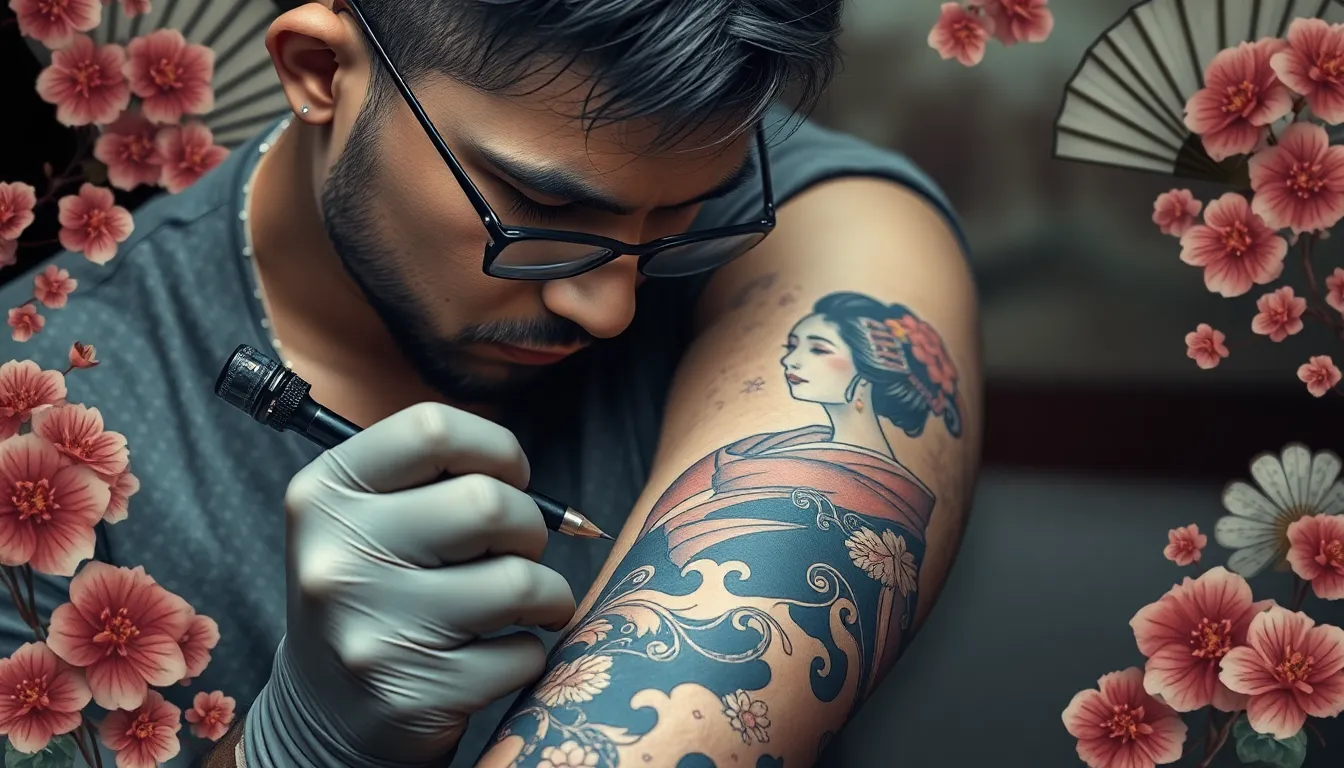
Moving from traditional warrior and animal motifs, we explore the elegant industry of geisha tattoos that celebrate feminine beauty and cultural artistry. These designs offer men a sophisticated way to honor Japanese aesthetics while showcasing artistic refinement.
Respectful Representation of Geisha Culture
Understanding the cultural significance behind geisha imagery forms the foundation of any meaningful tattoo design. We approach these tattoos with deep respect, recognizing that geishas represent grace, beauty, and traditional Japanese artistry rather than mere decorative elements. Avoiding stereotypical portrayals becomes essential when selecting your design, as these women served as accomplished artists and cultural icons throughout Japanese history.
Focusing on authentic representation means depicting geishas with dignity and understanding their historical role in Japanese society. We recommend working with artists who understand the cultural context and can create designs that honor rather than exploit this rich tradition. Choosing elements that reflect the geisha’s artistic nature like musical instruments, dance poses, or traditional ceremonies adds depth and authenticity to your tattoo.
Portrait Style vs. Stylized Approaches
Portrait style geisha tattoos capture the delicate facial features and intricate details that make these designs truly breathtaking. We see realistic approaches focusing on emotional expression, subtle makeup details, and authentic kimono patterns that create lifelike homages. Detailed work in this style requires skilled artists who can master fine line work and subtle shading techniques.
Stylized approaches blend traditional Japanese tattoo motifs with artistic interpretation for a more ever-changing visual impact. We often incorporate bold lines, geometric patterns, and traditional irezumi elements like birds or flowers surrounding the central figure. Modern interpretations combine classic Japanese tattoo aesthetics with contemporary artistic techniques, creating designs that feel both timeless and fresh.
Choosing between these styles depends on your personal preference and the overall composition of your tattoo. We find that portrait styles work exceptionally well for standalone pieces, while stylized approaches integrate seamlessly into larger Japanese tattoo collections.
Background Elements and Scenic Details
Cherry blossoms enhance geisha tattoos by symbolizing beauty and life’s transient nature, creating perfect thematic harmony with the central figure. We incorporate sakura petals flowing around the geisha to add movement and reinforce the connection to Japanese seasonal traditions. Traditional fans and parasols serve as both decorative elements and cultural symbols that complement the geisha’s elegance.
Flowing water and cloud motifs add balance and movement to your design while maintaining the traditional Japanese tattoo aesthetic. We often see these elements rendered in bold outlines with vibrant colors that make the entire composition pop. Scenic details like bridges, temples, and gardens help establish cultural context and create storytelling opportunities within your tattoo.
Background composition plays a crucial role in completing the narrative of your geisha tattoo. We recommend discussing placement and flow with your artist to ensure all elements work together harmoniously, creating a cohesive design that honors both the artistic tradition and your personal style preferences.
Japanese Skull and Skeleton Warrior Designs
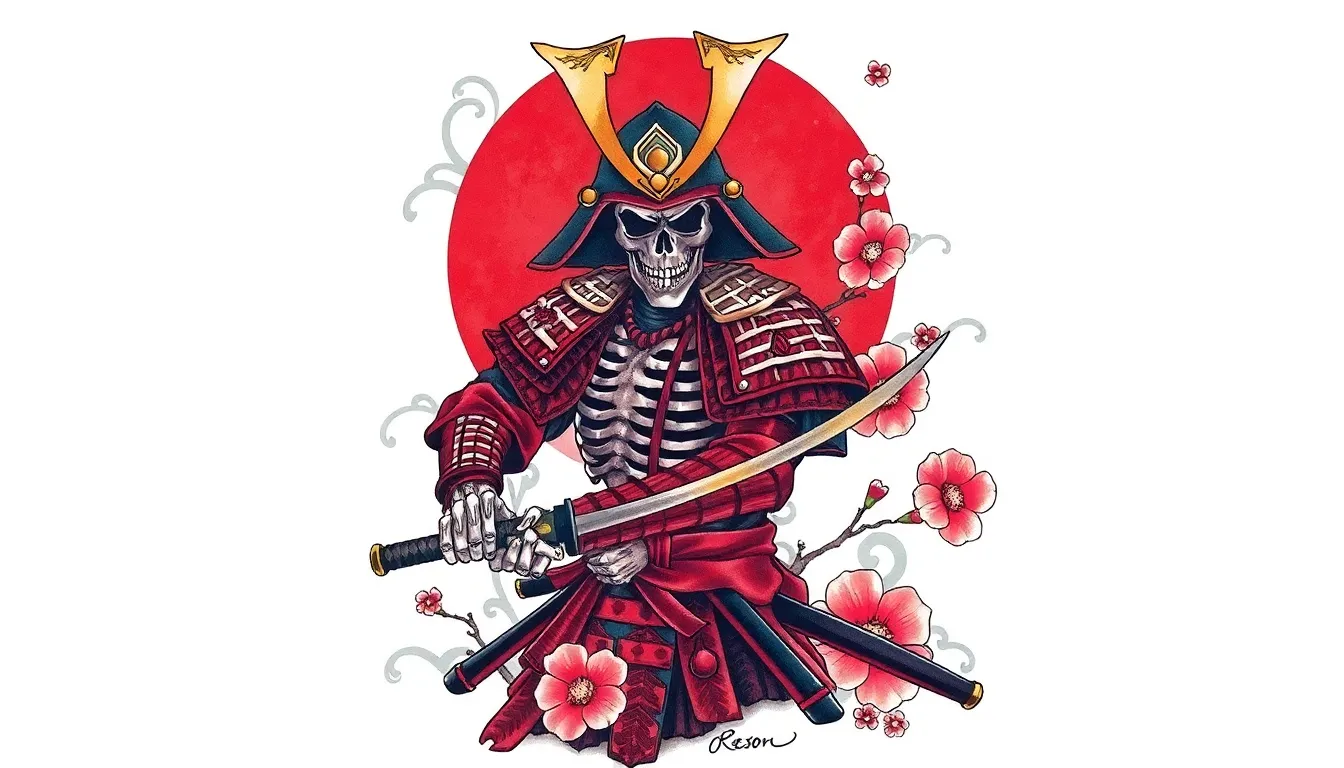
Japanese skull and skeleton warrior tattoos represent some of the most striking and symbolically rich designs in traditional irezumi art. These powerful motifs combine themes of mortality, honor, and supernatural strength that resonate deeply with men seeking bold body art.
Gashadokuro (Skeleton Specter) Mythology
Gashadokuro tattoos draw inspiration from one of Japan’s most fearsome yokai creatures, literally meaning “starving skeleton.” This mythical giant skeleton specter forms from the bones of people who died from starvation or on battlefields without proper burial rites, symbolizing unrest and vengeance against those who neglected them.
Traditional folklore describes the Gashadokuro as fifteen times larger than a human, roaming the countryside at night while producing haunting rattling and grinding sounds. Artists often incorporate these distinctive audio elements into tattoo designs through visual representation of bone fragments and ghostly movement lines.
The creature embodies themes of death, supernatural power, revenge, and the spiritual consequences of abandoning proper customs. Gashadokuro tattoos work exceptionally well as large back pieces or sleeve designs where the creature’s imposing size can be properly represented.
Modern interpretations blend traditional Japanese art techniques with contemporary horror aesthetics, creating designs that are both culturally authentic and visually striking for today’s tattoo enthusiasts.
Military and Samurai Skeleton Themes
Samurai skeleton tattoos masterfully blend images of traditional armor and weaponry with skeletal warriors, symbolizing the eternal warrior spirit that transcends death itself. These designs reflect core values of loyalty, bravery, and honor that persist even when faced with mortality’s inevitability.
Artists typically portray skeletal samurai wearing authentic armor pieces like kabuto helmets, do chest plates, and carrying traditional katana swords. Battle scene compositions add dramatic narrative elements that showcase the warrior’s dedication to duty beyond the physical area.
The skeletal aspect emphasizes life’s impermanence, a philosophical concept deeply embedded in Japanese culture through the Buddhist principle of mono no aware. This creates tattoos that are both visually powerful and philosophically meaningful.
Color schemes often incorporate traditional Japanese palette choices like deep blacks, rich reds, and gold accents that highlight armor details and weapon craftsmanship. Background elements such as cherry blossoms or storm clouds can further enhance the design’s emotional impact.
Dark Japanese Folklore Inspirations
Beyond Gashadokuro, many other yokai and supernatural entities from Japanese folklore provide rich inspiration for dark themed tattoos that emphasize mysterious and otherworldly aesthetics. Ghostly apparitions, vengeful spirits, and mythical creatures add cultural depth and symbolic complexity to skeleton warrior designs.
Incorporating traditional art elements like bold line work, flowing water patterns, and natural industry features helps frame supernatural figures within authentic Japanese artistic contexts. These design choices ensure cultural accuracy while creating visually cohesive compositions.
Artists often combine multiple folkloric elements within single pieces, creating narrative tattoos that tell complete supernatural stories. Wind patterns, floating lanterns, and ethereal mist effects can connect different mythological characters within unified designs.
Contemporary approaches blend classical yokai imagery with modern tattoo techniques, allowing for enhanced detail work and color gradients while maintaining traditional symbolic meanings and cultural respect.
Wind and Wave Pattern Tattoos
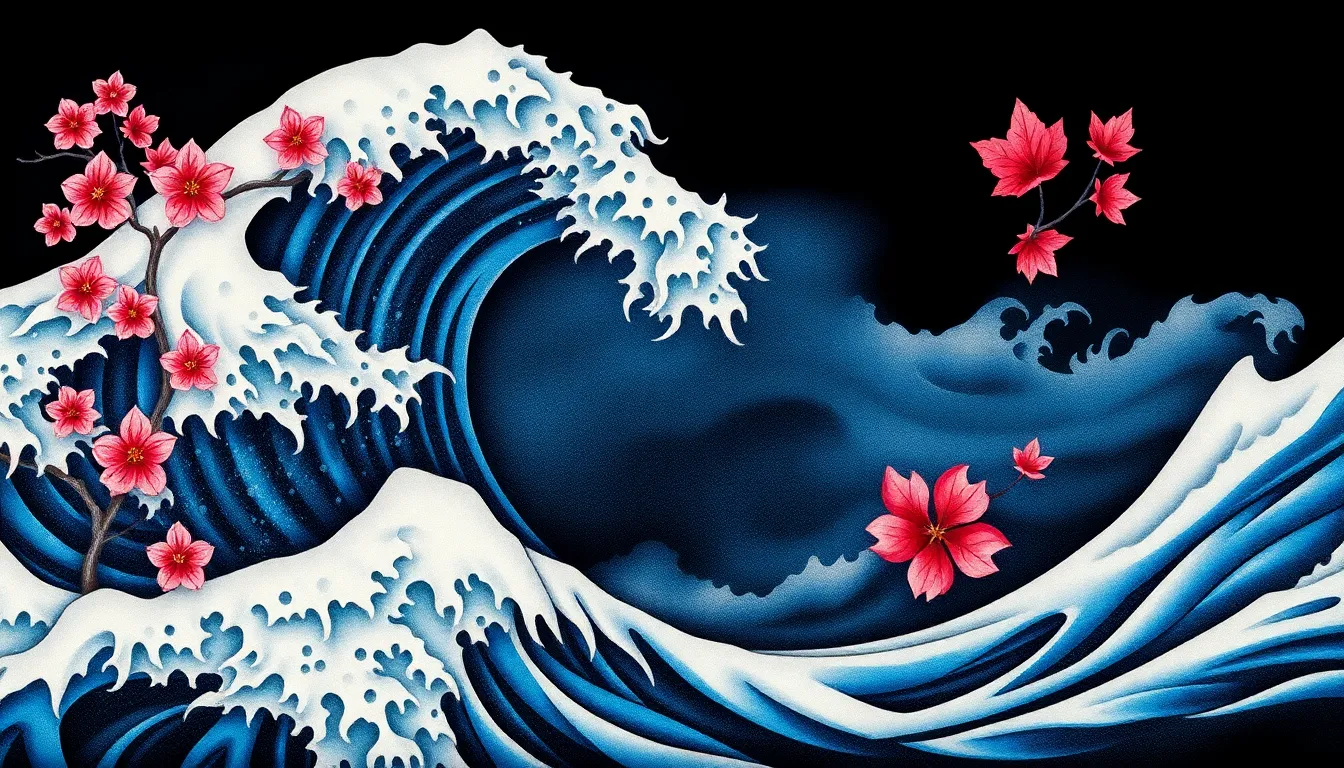
Wind and wave patterns represent some of the most ever-changing and spiritually important motifs in Japanese tattoo art for men. These designs capture the raw power of nature while embodying themes of strength, resilience, and life’s constant motion.
Traditional Japanese Wave Motifs
Traditional Japanese wave tattoos showcase stylized, swirling water patterns that demonstrate the ocean’s relentless movement and energy. These waves symbolize strength, resilience, and the unstoppable power of nature, reflecting a man’s endurance and adaptability in life’s challenges.
Wave patterns typically feature:
- Curved, flowing lines that create visual momentum
- Foam crests depicted as claw-like formations
- Varying depths and heights to show water’s complexity
- Bold outlines characteristic of traditional irezumi style
Artists often incorporate these motifs into larger sleeve pieces or back tattoos, where the wave’s natural flow complements the body’s contours. The swirling patterns create excellent transitions between other design elements like dragons, koi fish, or samurai warriors.
Hokusai’s Great Wave Inspiration
Hokusai’s Great Wave off Kanagawa serves as the most iconic inspiration for Japanese wave tattoos worldwide. This renowned woodblock print showcases a gigantic wave poised to crash over boats, perfectly embodying both natural beauty and terrifying power.
Key design elements from Hokusai’s masterpiece include:
- Dramatic curved crests that tower menacingly
- Frothy white foam depicted as reaching fingers
- Mount Fuji’s subtle presence in the background
- Perfect balance between chaos and artistic control
Tattoo artists adapt this famous wave’s dramatic curves and foam details for various body placements including sleeves, backs, and chest pieces. The design conveys the wearer’s respect for nature’s force and life’s impermanence, making it particularly meaningful for men seeking profound symbolism.
Modern interpretations often scale the wave to fit exact body areas while maintaining the original’s powerful visual impact and cultural significance.
Incorporating Wind Bars and Natural Elements
Wind bars, known as kaze in Japanese, frequently accompany wave tattoos to depict air movement and enhance the composition’s overall fluidity. These curved lines complement wave patterns perfectly, evoking motion and energy throughout the design.
Common natural elements paired with wind and waves include:
- Cherry blossoms (sakura) representing life’s fleeting beauty
- Maple leaves (momiji) symbolizing seasonal change and time’s passage
- Chrysanthemums (kiku) embodying longevity and rejuvenation
- Clouds (kumo) adding atmospheric depth and movement
Artists strategically place these elements to create visual narratives that enhance the tattoo’s cultural depth and personal meaning. Bamboo stalks often frame wave compositions, while pine trees add stability and endurance themes to the ever-changing water movement.
Color combinations typically feature:
| Element | Traditional Colors | Symbolic Meaning |
|---|---|---|
| Waves | Blue, white, gray | Power, purity, mystery |
| Wind bars | Light blue, silver | Movement, spirit, change |
| Cherry blossoms | Pink, white | Beauty, impermanence |
| Maple leaves | Red, orange, yellow | Transformation, seasons |
Contemporary tattoo artists blend these traditional motifs with modern techniques, creating versatile designs that honor Japanese cultural heritage while meeting today’s aesthetic preferences. The combination of wind, waves, and natural elements creates powerful statements about strength and harmony with nature’s forces.
Conclusion
Japanese tattoo art offers men an extraordinary canvas for personal expression through centuries-old traditions and powerful symbolism. Each design we’ve explored carries deep cultural significance while providing endless opportunities for customization and artistic interpretation.
Whether you’re drawn to the fierce strength of dragons and tigers or the delicate beauty of cherry blossoms and waves these tattoos create meaningful connections between ancient wisdom and modern identity. The versatility of Japanese motifs allows for both bold statement pieces and subtle artistic elements.
We encourage you to work with experienced artists who understand traditional irezumi techniques and cultural contexts. This collaboration ensures your chosen design honors Japanese heritage while reflecting your personal journey and values through timeless artistry.
Frequently Asked Questions
What makes Japanese tattoos particularly appealing to men?
Japanese tattoos offer powerful masculine symbolism through designs like dragons, samurai warriors, and tigers. These tattoos embody themes of strength, honor, and transformation while providing bold visual statements. The rich cultural heritage and deep meanings behind each design allow men to express their personality and values through meaningful body art.
What do dragon tattoos symbolize in Japanese culture?
In Japanese culture, dragons represent power, wisdom, and spiritual strength. Unlike Western dragons, Japanese dragons are benevolent creatures associated with water, weather, and good fortune. They symbolize protection, transformation, and the ability to overcome challenges, making them popular choices for men seeking meaningful tattoo designs.
What is the significance of samurai warrior tattoos?
Samurai warrior tattoos embody honor, discipline, courage, and unwavering strength. They represent the bushido code and traditional Japanese values of loyalty and sacrifice. These designs often include detailed armor, weapons, and historical figures, making them powerful symbols of masculine virtues and personal integrity.
What do koi fish tattoos represent?
Koi fish tattoos symbolize perseverance, determination, and transformation. In Japanese folklore, koi that swim upstream and overcome obstacles can transform into dragons. These tattoos represent personal growth, the ability to overcome adversity, and achieving one’s goals through persistence and courage.
Are geisha tattoos appropriate for men?
Yes, geisha tattoos can be appropriate for men when done respectfully. These designs celebrate Japanese cultural artistry and feminine beauty. It’s important to understand that geishas are accomplished artists and cultural icons, not decorative elements. Proper representation honors their cultural significance and artistic tradition.
What do Oni demon mask tattoos symbolize?
Oni demon mask tattoos represent protection against evil spirits and negative forces. In Japanese folklore, Oni can be both malevolent and protective. These masks symbolize strength, courage, and the ability to ward off bad luck, making them popular protective talismans in tattoo form.
What is the meaning behind cherry blossom (sakura) tattoos?
Cherry blossom tattoos symbolize the beauty and fragility of life, representing the Japanese concept of mono no aware (the bittersweet awareness of impermanence). They signify renewal, the fleeting nature of life, and the importance of appreciating beauty in the present moment.
How do tiger tattoos differ from dragon tattoos in Japanese art?
Tiger tattoos represent raw power, courage, and ferocious strength, while dragons symbolize wisdom and spiritual power. Together, they create symbolic balance between chaos and order, earth and heaven. Tigers are often depicted in natural settings, emphasizing their connection to the physical world.
What are Gashadokuro tattoos?
Gashadokuro tattoos feature skeletal yokai creatures from Japanese folklore, representing massive skeletons formed from the bones of those who died of starvation or in battle. These designs symbolize unrest, vengeance, and the supernatural, combining themes of mortality with dramatic visual impact.
What do Japanese wave tattoos symbolize?
Japanese wave tattoos represent strength, resilience, and life’s constant changes. Inspired by traditional art like Hokusai’s Great Wave, these designs symbolize the power of nature and the ability to flow with life’s challenges. They often incorporate wind patterns and natural elements for enhanced meaning.
